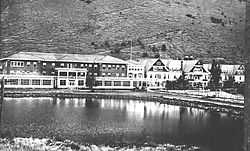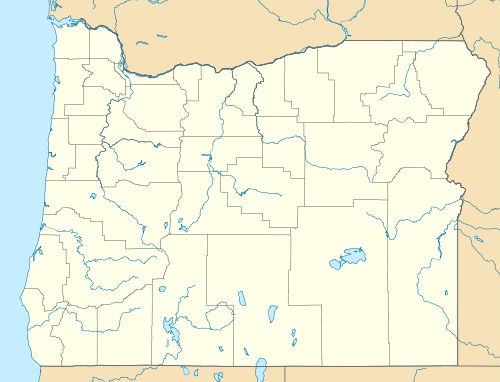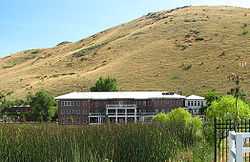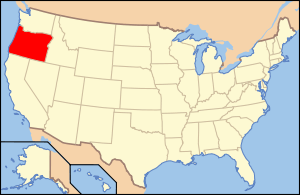Hot Lake Hotel
|
Hot Lake Resort | |
 | |
|
Hot Lake Hotel and Sanitarium, circa 1920s; the wooden gabled structure on the right side would later burn down in a 1934 fire. | |
 | |
| Nearest city | La Grande, Oregon |
|---|---|
| Coordinates | 45°14′36″N 117°57′24″W / 45.24333°N 117.95667°WCoordinates: 45°14′36″N 117°57′24″W / 45.24333°N 117.95667°W |
| Built |
1864 (original building) 1906 (final structure) |
| Architect | John V. Bennes[1][2][3] |
| Architectural style |
Colonial Revival Shingle Style |
| Governing body | Private |
| NRHP Reference # | 79002148[4] |
| Added to NRHP | March 15, 1979 |
Hot Lake Hotel is a hotel originally built in 1864 in Hot Lake, Union County, Oregon, United States.[5][6] Prior to white settlement of the area, the hot springs that fed Hot Lake may have been used as a meeting ground for various Indian tribes. During its history, the facility was used as a medical facility, a rest stop for travelers and a resort due to its relaxing thermal waters. The building was in operation in one form or another until 1974. After that, operations were intermittant under various owners. Today, it is operated as a bed and breakfast, museum, and spa. Prior owners included future governor Walter M. Pierce and former state senator Parish L. Willis.[7]
History
The hot springs themselves rest at the foot of a large bluff, and were often used by Native Americans before settlement and colonization occurred in the area; the lake was named "Ea-Kesh-Pa" by the Nez Perce.[6]
Construction and heyday (1864-1931)
In 1864, Fitzgerald Newhard built the first wooden structure of the building, which faced toward the bluff rather than outward toward the lake. The structure was similar to the contents of a modern-day shopping mall, containing a post office, blacksmith, dance hall, barber shop, bath house, and several other businesses.
By 1884, the Union Pacific Railroad commenced its construction, running near Hot Lake. In 1903, the original wooden structure was demolished, and construction began on a new hotel and various bath houses. Dr. Phy became involved with the project in 1904, and the brick structure of the building began to be built two years later. Well-renowned architect John V. Bennes of nearby Baker City has been attributed to the architectural design of the building, reminiscent of the Colonial era;[1] Bennes also designed countless buildings on the Oregon State University campus, as well as several buildings in Portland, Oregon. By 1908, the brick building was complete, housing just over 100 guest rooms. Soon after, the Central Railroad of Oregon built a 4-mile (6.4 km) line from Richmond directly to the hotel in 1912.[8]
In 1917, Dr. Phy purchased the hotel and resort, renaming it "Hot Lake Sanitorium", housing guest rooms, medical wards, offices, and a kitchen/dance hall. The building was from then on known not only as a resort for the rich, but also as a hospital for the ill; the geothermal mineral waters from the springs were used and experimented with to help treat patients and guests, making the resort a pioneering figure in western experimental medicine.[6][9]
By 1924, the hotel was a major tourist attraction; countless new visitors arrived daily from all over the world. The Mayo brothers, founders of the Mayo Clinic, were frequent visitors to the hotel, as well as Wild Bill Hickok.[9] Dr. Phy, the central manager and owner of the property, died in 1931 of pneumonia.
Fire and later years (1934-1991)

On May 7, 1934, a fire destroyed the majority of the building's right side,[10] completely demolishing the wooden structures of the hotel; the 65,000-square-foot (6,000 m2) brick portion of the building, however, survived. The building had contained nearly 300 rooms and dining areas for over 1,000 guests prior to the fire. From then on, business at the hotel declined, and eventually the hospital area on the third floor was the only functioning business.
A flight school and nurse's training center was established at the hotel during World War II, and U.S. Route 30 was later built, with Oregon Route 203 branching off of it and running right by the front of the hotel grounds. The attraction of the complex declined in later years, and its use as a resort came to a halt in 1953 when it was converted solely to a nursing home, and later an asylum.[11] By 1975, ownership of the building had changed, and a short-lived restaurant and night club was opened, which only ran for two years.
In the mid-1980s, Dr. Lyle Griffith purchased the property and used one corner of the hotel as a bath house; by 1991, the bath house closed down, and the hotel was abandoned, falling prey to local vandals and the elements.

The building sat abandoned and decrepit for over fifteen years, and various stories circulated concerning reported hauntings in the hotel— it has been rumored to be haunted by old vacationers, a gardener who committed suicide, and insane people from the building's nursing home/asylum days. When the hotel was originally constructed it acquired a piano formerly owned by Robert E. Lee's wife, which was said to play all by itself up on the third floor.[12] Other reports of screaming and crying were reported by owner Donna Pattee and caretaker Richard Owens coming from the hospital's surgery room, as well as rocking chairs moving at their own accord; Pattee and her husband owned the property in the 1970s when it was a restaurant; both they and Owens lived on the second floor of the building at the time.[12]
The hotel was featured on ABC's The Scariest Places on Earth in 2001.
Restoration (2003-present)
In 2003, the building, which was literally falling apart, was purchased from Charles and Louise Rhea by David Manuel.[13] Restoration began soon after; the building was greatly dilapidated, with all 368 windows broken and/or missing, and a sparsely-remaining roof. After two years of construction, it was opened to the public for tours in 2005, while individual guest rooms were still being sponsored and renovated. In 2008, the west wing of the building collapsed.[14] As of 2010, the building now functions as a bed and breakfast, with dozens of restored rooms, a spa, restaurant, and a museum. The hotel's original pool was covered with landscape, but new mineral pools are under construction.[13]
The hotel is part of the Hot Lake Resort, which was listed on the National Register of Historic Places in 1979.[4][15]
See also
- National Register of Historic Places listings in Union County, Oregon
- Reportedly haunted locations in Oregon
References
- ↑ 1.0 1.1 Landis, Larry. "John V. Bennes (1867-1943)". The Oregon Encyclopedia. Portland State University. Retrieved February 6, 2015.
- ↑ "Oregon Historic Sites Database". Retrieved May 18, 2010.
- ↑ Landis, Lawrence (February 5, 2008). "John Bennes and OSU's Architectural Legacy, 1907-1941". Oregon State University: Valley Library. Retrieved May 18, 2010.
- ↑ 4.0 4.1 "National Register Information System". National Register of Historic Places. National Park Service. 2008-04-15.
- ↑ Barklow, Irene (1987). From Trails to Rails: The Post Offices, Stage Stops and Wagon Roads of Union County. Enterprise, Oregon: Enchantments Publishing of Oregon. pp. 158–161. ISBN 0-9618185-0-6.
- ↑ 6.0 6.1 6.2 "Hot Lake Springs: Timeline". Retrieved December 29, 2009.
- ↑ Clarke Woodward Drug Co. v. Hot Lake Sanatorium Co., 88 Ore. 284, 169 P. 796 (1918). West Publishing Company.
- ↑ Deumling, Dietrich (May 1972). The roles of the railroad in the development of the Grande Ronde Valley (masters thesis). Flagstaff, Arizona: Northern Arizona University. p. 72. OCLC 4383986.
- ↑ 9.0 9.1 Frazier, Joseph B. (March 9, 2007). "Hot Lake Springs: A reminder of gentler times". USA Today. Retrieved May 18, 2010.
- ↑ Mason, Dick (August 2, 2008). "The Hot Lake Story". La Grande Observer. Retrieved May 19, 2010.
- ↑ Hicks, James. "Strange Destinations". Strange USA. Retrieved May 18, 2010.
- ↑ 12.0 12.1 Smitten, Susan (2001). Ghost Stories of Oregon. Lone Pine Publishing, Inc. pp. 53–56. ISBN 1-894877-13-6.
- ↑ 13.0 13.1 "Hot Lake Springs, Manuel Museum and Foundry". Retrieved May 19, 2010.
- ↑ "Hot Lake Springs, Manuel Museum and Foundry: Hot Lake Facts". Retrieved May 19, 2010.
- ↑ oregon.gov: Oregon National Register List
Further reading
- Roth, Richard R. The Hot Lake Story (2008) Heritage Quest Press, Orting, Washington ISBN 978-0-9821849-0-5
- Roth, Richard R. The Hot Lake Story - Heritage Supplement (2011) Heritage Quest Press, Orting, Washington ISBN 978-0-9821849-5-0
- Roth, Richard R. The Hot Lake Story - 2012 Supplement (2012) Heritage Quest Press, Orting, Washington ISBN 978-0-9821849-6-7
- Roth, Richard R. The Central Railroad of Oregon - Oregon's Blue Mountain Route (2015) Heritage Quest Press, Orting, Washington ISBN 978-1-62859-027-2
External links
| Wikimedia Commons has media related to Hot Lake Hotel. |
- Hot Lake Springs (official website)
- "Hot Lake Springs: A reminder of gentler times" from USA Today
- Images of Hot Lake Hotel from the University of Oregon Digital Archives
- Oregon Historic Sites Database: Hot Lake Resort
- Oregon Historic Sites Database: Hot Lake Resort Bath House

